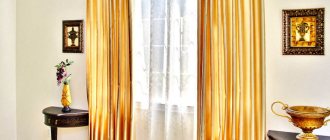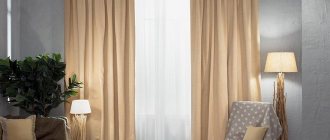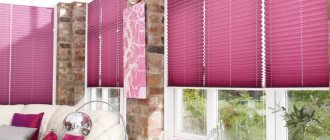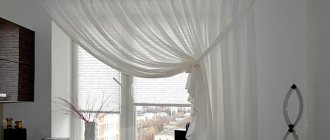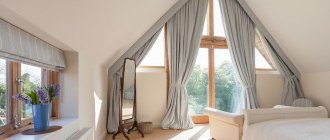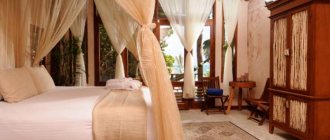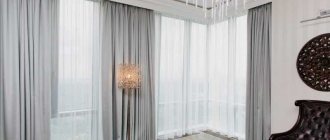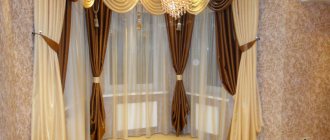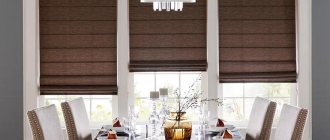What are Viennese curtains
Curtains in a similar style appeared in the 18th century. The principle of operation came from Roman curtains, and the elegant appearance from French curtains. The products are a rectangular sheet attached to a cornice. Cords run vertically along the entire length of the material, with the help of which the fabric can be gathered into folds and scallops or raised.
Difference from French curtains
Austrian curtains are a flat fabric gathered along the bottom edge. This is their main feature. When raised, the straight fabric gathers into lush tails. The material consumption for sewing such products is economical.
French curtains have voluminous folds running along the entire length of the fabric. When collected they are lush, but when lowered they are soft and wavy.
What is the difference?
Austrian curtains are a flat fabric, slightly gathered along the bottom edge, or in the form of a lush drapery. The lushness of the curtains is reminiscent of French ones, and the presence of a mechanism is reminiscent of Roman ones. If you lift the fabric, the fabric forms folds - puffs or scallops.
A detailed examination of the photo depicting Austrian curtains shows that they require a cornice with a mechanism built inside.
Using cords secured on the reverse side, the uniformity of scallops is ensured. Sometimes the top of the fabric is treated with ribbon braid, which makes the puffs more voluminous.
Suitable fabrics
For tailoring, soft, well-draped materials are selected. They can have different densities and ability to transmit light. When choosing fabrics, it is important to take into account the style of the interior, the overall color scheme and the direction of the world on which the windows face.
Tulle
The translucent material drapes easily and lets in a lot of light. Viennese curtains made from this fabric are complemented with classic curtains or lambrequins.
Veil
The rare-woven mesh fabric drapes beautifully, allowing you to create graceful folds. The lower edge of curtains made of this material is decorated with lace, glass beads, and hand stitching.
Organza
Thin translucent fabric is stiffer than tulle. It is assembled into voluminous, breakable folds, thanks to which curtains made from it fill the room with light and give it a special charm.
Guipure
Openwork material is chosen for sewing Viennese curtains if it is necessary to focus attention on the windows. It is decorated with tassels or fringe, giving the interior a solemn look.
Linen
The natural material forms uniform deep folds. It protects the room from prying eyes and excess sunlight.
Velours
Viennese curtains made of this material give the interior a solemn look and are used when decorating windows in large rooms. They are complemented with tassels, lambrequins, cords, and fringe.
Choosing fabric for Austrian curtains.
Austrian curtains can be used both as a decorative element of the interior and as a functional part. In principle, the choice of fabric for them depends on this. Such curtains can be purchased ready-made; there is now quite a wide choice of colors and materials. You can also order curtains based on individual preferences and the characteristics of the room, or make them yourself at home, which is also very exciting and not difficult.
Austrian curtains photo
When choosing fabric for these curtains, you need to consider what role they will serve and in what room they will be used. For example, for the kitchen it is better to choose a fabric that is lighter, softer and translucent, so that there is more light and in general there is no feeling of heaviness. Also, excessive pomp for the kitchen will be unnecessary, so light drapery below will be enough.
Austrian curtains for the kitchen photo
For the bedroom, you can make the drapery more voluminous, the fabric is translucent, if the curtains are complemented by drapes or thick. Thicker fabrics are suitable for a living room or study; they can also be supplemented with curtains or a lambrequin. You just need to take into account that the denser the fabric, the rougher the drapery below will turn out, and the lighter and softer the fabric, the more magnificent and interesting their edges will be.
Austrian curtains in the bedroom photo
For Austrian curtains, it is better to choose plain fabrics or with a small pattern; if there is a large ornament, then due to the assembly it will not be completely visible, which will hide all the beauty of this pattern. When choosing a color scheme, it is better to give preference to pastel shades: milky, cream, beige, pink, soft green, blue. Such colors in the interior, in particular on curtains, will create an atmosphere of comfort, warmth and lightness, and also in combination with drapery they will look very original. The lower gathering can also be decorated with special tassels, ruffles, frills, which will add even more sophistication to the room. If you also want to emphasize the splendor of the folds of these curtains, then you can choose shiny fabrics, such as silk or organza, to sew them.
Austrian curtains photo
As for the mechanism of these curtains, it is very simple and easy to use. There is a pocket on top through which a wooden strip is threaded; the height is adjusted using cords threaded into rings. The cords play both a decorative role, giving splendor and creating a certain shape to the curtains, and a functional one, since they serve as a lifting mechanism.
Austrian curtains in the interior photo
Austrian curtains do not need to be pulled apart, but only raised or lowered using cords. The advantage of such a lifting mechanism is that it can help save you space; this need usually arises when the room area is small.
Austrian curtains photo
Thanks to their originality and splendor, Austrian curtains can enliven any environment and create coziness in it. They are not only beautiful, but also practical; they can be used to decorate the interior or protect the room from bright sunlight thanks to the dense drapery. These curtains are ideal for rooms of different sizes and almost any interior.
Suitable interior styles for application
Austrian-style curtains are used to decorate rooms in classic and modern styles. In combination with the rest of the decoration, they help set accents and give the room a well-groomed look.
Provence
For an interior in this style, samples made of simple linen fabrics with a checkered, striped or floral pattern are suitable. Such curtains maintain the overall atmosphere and refresh the look of the room.
Vintage
When decorating windows in the interior of such a room, Viennese curtains made of flowing materials in the spirit of old times (brocade, velvet, velor, silk, taffeta) are used.
The main task is to choose the length and shade of the curtains and form the drapery.
Classical
Austrian-style curtains are used to decorate windows in large rooms. They are made from translucent materials, the light drapery of which looks sophisticated.
Modern
These curtains add a touch of chic to a modern setting. They are sewn from thin transparent fabrics that give the room lightness.
American
Austrian curtains made of opaque materials with small ornaments or geometric patterns will allow you to emphasize the neatness and presentability inherent in this style.
They can have a simple cut and barely visible drapery along the edge.
What is an Austrian curtain in an apartment interior?
Austrian or scalloped curtains are a hybrid of French and Roman curtains. From the first they adopted beautiful vertical ruffles, and from the second they adopted the lifting mechanism. Thus, Austrian curtains can be raised, but at the same time have a rather pompous appearance.
When unraveled, Austrian curtains are a rectangular piece of fabric with special rings on the reverse side. These elements are sewn at a distance depending on the size of the scallops you want to get.
Two thin but strong cords are inserted into these rings. By tightening them, you get a curtain with large horizontal ruffles.
The Austrian curtain is attached to a curtain rod that has a rotor-chain mechanism, or to a curtain rod. It all depends on whether you need the curtain to move horizontally.
Austrians are not suitable for every interior. There are rooms in which such textile components cannot be used. This mainly applies to apartments with modern and sleek designs.
Interiors in which Austrian curtains cannot be used:
- High tech;
- Modern;
- Loft;
- Constructivism.
Such curtains will look great in classic interiors such as Empire style. However, some modern romantic interiors can also be complemented with such textiles. For example, if you choose a curtain with the right shade, it will be quite suitable for rustic country or elegant Provence.
Fabric colors
When choosing a pattern and color of a material, it is important to take into account the features of the interior, the area of the room and the degree of its illumination. It is not necessary to use plain fabrics.
With flowers
Flowers on the curtains soften the atmosphere and bring a feeling of celebration. Light and sophisticated designs create a joyful and soulful atmosphere in the interior.
Floral patterns
When decorating windows, designers often use curtains with fashionable patterns. The canvases contain curls, vines, leaves, petals and other natural elements.
Ornaments
Original drawings focus attention on the windows and transform any room. Viennese curtains with patterns add sophistication and charm to the simplest furnishings.
Geometry: stripe, check
Curtains with clear geometric patterns add laconicism and rigor to the decor. They are appropriate in living rooms, offices, and kitchens. Light draperies and waves along the edge soften the overall appearance.
Design and decor options
The products require a cornice with a lifting mechanism. They come with tight cords that are attached from the inside out and ensure uniform drapery.
Multilayer
Such curtains are created from several canvases that are harmonious with each other in shade and design. A popular combination of thick and translucent fabric, complemented by a lambrequin and draperies.
On bows
In this interpretation, the fabric flows freely, and the drapery is decorated with beautifully tied bows. By fixing the folds, they give the window decor a festive look.
Lace
The use of openwork elements brings warmth and lightness to the interior. Austrian curtains decorated with lace are usually combined with thicker types of curtains.
With bugles
Fittings and fringe with glass elements are used to give the room a light and glamorous look. Such fittings are combined with accessories made of crystal and Swarovski crystals.
From threads
Elegant and thin, like a cobweb, canvases allow you to create interesting decorative solutions. Such curtains look especially impressive in the decoration of living rooms and restaurant halls.
Caring for Austrian curtains
To remove the fabric from the curtain rod, the lifting cords are first removed from the rings, and then the Velcro is unfastened. Washing is done by hand or on a delicate cycle. Before washing, curtains are placed in special bags.
It is convenient to clean heavy textiles from time to time, removing dust from the folds, using a vacuum cleaner with a special attachment. Fabrics that require special “dry” treatment, for example, velvet, are best taken to dry cleaning. Wool and natural silk products do not tolerate moisture well. Fringe, glass beads, soutache and other types of trim that may be damaged during washing are first stripped off.
Veil and organza are washed in lukewarm water at a temperature of up to 30 °C without spinning. Recommended mode: hand wash. High-quality organza does not need to be ironed.
Mounting options for cornice
There are several options for attaching Viennese curtains:
- to the ceiling;
- wall above the window;
- cornice;
- frame;
- slope above the window.
Curtains can come complete with a curtain rod equipped with a closed or open lifting mechanism.
Velcro
To hang light canvases on the cornice strip, fastening with Velcro tape is used. It consists of soft and hard parts and is attached to a window, wooden plank or wall. When fixing to the cornice, loops are used.
With strings
Curtains with loops and ties look original in the interior. Curtains are secured to the curtain rod using cords, ribbons or textile strips, which are tied with a bow or beautiful knots.
How to sew Austrian curtains with your own hands?
You can sew Austrian curtains yourself
We have already figured out what Austrian curtains are, now we will try to create them on our own. So what do we need?
Materials
a simple DIY version of Austrian curtains
The fabric should be of a soft texture and preferably wrinkle-resistant. Ironing Viennese curtains is a thankless task. You need to take at least 2 widths, plus take into account allowances for finishing the edges.
If you choose a model with a lining, then we immediately resolve the issue of purchasing fabric for the bottom layer. The amount of the latter is calculated using the same parameters as for the main one.
sheer Avestan curtains
As you can see in the photo, Austrian curtains for the nursery, kitchen, and bedroom are often hung on a cornice using curtain tape with loops . If this is convenient for you, then we buy consumables, focusing on the length of the cornice strip.
To create folds and adjust their depth, a tightening tape is used. It can be replaced by braid with rings.
Accessories. Their role can be beads, tassels or other decorations that can be attached to the end of the cord.
Sewing
elegant Austrian curtain in the bathroom
Now the process of how to sew Austrian curtains with your own hands.
- We fold the main and lining sections with the right sides facing each other. Sew along the bottom and sides. Turn it inside out.
- Sew on fringe or ruffles, if provided for by the pattern.
- We turn the product inside out and mark vertical lines for assembly. The mounting tape will be sewn along them. We thread a nylon cord through the rings, fix the upper end of it to the first drawstring, and decorate the free end with a tassel or other accessory.
- We attach a curtain tape to the top edge and we can decorate the window.
Austrian curtains give any interior a glamorous look
As you can see in the photo, Austrian curtains used in the kitchen interior often have assembled cords only in the center of the canvas. The free-hanging sides give the composition an incredibly glamorous look.
Master class on sewing Austrian curtains with your own hands
Before work you should prepare:
- sewing machine;
- scissors;
- threads matching the color;
- base for curtains;
- braid or tightening tape;
- nylon cord;
- curtain tape.
Lining fabric is required if necessary.
Choice of fabric and design
If priority is given to pronounced folds, emphasized shapes and accentuated flounces, you should purchase dense, smooth fabrics (satin, linen, satin). When smooth, wavy transitions are needed, you should focus on flowing fabrics (silk, velor, tulle).
How to determine dimensions
The width of the finished product should be 2 times the length of the cornice. The dimensions of the model are calculated by their location on the window. The length of the product is calculated depending on how the curtain will hang. If the curtain is straight when lowered, it is equal to the distance from the cornice to the floor.
When determining the length of the cord, the number of gathering strips is multiplied by the size of the fabric allocated for folds. Take into account how much the cord will exceed the edges of the fabric. The resulting values are added and multiplied by the number of stripes.
Step-by-step instruction
Before cutting, you should familiarize yourself with the drawing of the curtain, and also steam the prepared fabric.
Main stages of sewing:
- Cut a piece of fabric of the required size, taking into account allowances.
- Using the pattern, mark with chalk where the curtain tape goes.
- Topstitch the side hem.
- Hand sew the braid into place.
- Fold the fabric over 5 cm and stitch.
- Attach a ribbon along the seam for hanging.
- Turn it inside out and stitch.
- Process and decorate the bottom edge according to the design plan.
- After each line, iron the fabric.
On the finished product, carefully tighten the tape and secure the cords. Assembly will be facilitated by a lifting mechanism that is inserted from the side and attached to the top of the cords.
Curtains made from ready-made curtains
Using the principle described above, you can alter curtains from old curtains. It is recommended to decorate them with fringe, bows or braid.
An easy way to drape Austrian curtains
A modern way to give Viennese curtains an attractive look is to use drapery tape. It is sewn on the sides of each row of folds. The braid can be carefully tied and periodically unraveled, resulting in a smooth fabric.
Advantages and disadvantages of Austrian curtains
The decision to use Austrian curtains in the interior is due to the following advantages:
- Easy to care for. To give your curtains a fresh look, just vacuum them using a small attachment or wipe them with a barely damp cloth.
- Original look.
- More functionality compared to conventional curtains. Austrian curtains take up very little space, do not fly apart due to drafts, and can also effectively regulate the illumination of a room. There is direct access to the windowsill, where you can easily care for flowers without getting tangled in long tulle.
- Resistant to external factors. Properly chosen textiles for Viennese curtains do not fade in the sun.
- You can sew it yourself. A simple cut and minimal fabric consumption allow you to do this work yourself.
This type of curtains is beautiful and original. Like any piece of furniture, Viennese curtains have not only advantages, but also disadvantages:
- When the curtains are drawn, the window cannot be opened.
- To wash it in a washing machine, you need to completely remove the guides and fastenings, and this is a rather labor-intensive process, especially the subsequent installation of them in place.
If the curtains are drawn, it will not be possible to open the window freely.
A hand steamer will be a good assistant in the process of cleaning Viennese curtains. It will not only give freshness to the fabric, but also remove dust mites and various bacteria.
Options for combining with other types of curtains - blinds, roller tulle
Translucent and transparent Austrian curtains are combined with classic drapes, which are located on the sides of the window. Modern combinations using blinds, lambrequins, roller blinds and Roman blinds expand the possibilities of their use.
In which rooms can you use photos in the interior?
Viennese-style curtains fit effectively into almost any living space, including offices and bathrooms. Photos of the interiors will allow you to verify this.
In the living room
In rooms with large windows, brightly colored curtains can be used as an accent. A combination with tulle will help emphasize the richness of the cut and material.
In the bedroom
Curtains made of pastel-colored fabrics will create a romantic atmosphere. They will be complemented by translucent flowing curtains.
In the nursery
Light tulle with cheerful patterns is suitable for a preschooler's nursery. At an older age, girls are given fabrics in pastel shades, decorated with fringe and lace. The solution for boys is curtains in calm colors.
In the kitchen
The optimal length of curtains is up to the window sill. When choosing the type of fabric, you should prefer synthetics: it absorbs odors less and is resistant to stains.
In the office
Austrian curtains in a classic style are selected for work spaces and business offices. Dark, soft colors and lack of decor are preferred.
In public places
Viennese style is a suitable idea for decorating restaurant halls and marriage registrations, theater foyers, dining rooms and other public places. When holding corporate events, it is appropriate to decorate windows with silk curtains and veils.
Austrian curtains: how to include them in the interior?
Before you sew Austrian curtains, ask yourself whether they will be appropriate in your home. After all, despite the fact that they look good in almost any style, there are exceptions - loft, high-tech, constructivism, brutalism and other distinctly modern trends.
Since “Austrian women” were originally decorations for aristocratic chambers, they look best in a classical frame. It can be Empire, Victorian and Georgian styles, Baroque and Rococo. Austrian curtains also look very gentle and elegant in interiors decorated in the spirit of Provence and vintage. Well, if you use natural materials like homespun cotton and linen, which have a characteristic “rural” print, this type of window textile will become a welcome guest in country interiors.
Application options for non-standard shaped windows
Window openings of unusual shape (rectangular, arched, bay windows) are a bright accent of the interior. When decorating them with the help of Austrian curtains, original solutions are used.
On an arched window
Viennese curtains are used to decorate arched windows of any shape. The main task is their correct installation and compliance of the design with the overall concept of the room.
Bay window
When decorating windows located in a room that extends beyond the plane of the facade, you should choose multi-layer curtain options. A good solution is a combination of thick curtains with Viennese curtains made of translucent fabric in suitable shades.
Window with balcony door
The use of fabrics of different densities allows you to hide the exit to the balcony and at the same time let in enough light. The structure is made according to the size of the opening.
On the windows along the stairs
Tall windows along staircases in palaces, cottages and other spacious rooms are highlighted using asymmetrical compositions. When decorating, light and elegant materials are used, which give the atmosphere a solemn and pompous look.
Austrian curtains for a romantic bedroom
The decor for bedroom windows should shade the room as much as possible to ensure a comfortable and restful sleep. The soft folds of Austrian curtains can provide the necessary twilight during daytime rest and prevent the penetration of moonlight and street lamps at night. Translucent tulle will not work as the main curtain; natural dense fabrics are needed. Or install blinds on the windows or additionally hang thick curtains.
The opinion that Austrian curtains are suitable for a child’s or girl’s room is erroneous. The men's bedroom will be perfectly complemented by Viennese curtains made of fabric with a dense texture. The color scheme for coffee with milk or khaki and sculptural festoons will emphasize the brutality of the interior.
For a family bedroom, soft pastel shades to match the rest of the decor and furniture are suitable. In the relaxation room, there should be no color contrast between the curtains and other details. Fans of bright colors can add a couple of “screaming” elements: red cords or rich green tassels on light translucent tulle, or rich blue fringe on pale blue scallops.
Window design in interior design is considered to be an important detail, since it is the only element that is available to everyone. Therefore, special attention should be paid to the selection of curtains and you should not cover the window opening with a simple silk curtain. Often, an expensive and elegant design is spoiled by poor-quality fabric on the curtains or an ineptly chosen window decor style.
